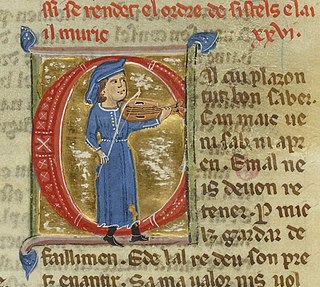
A troubadour was a composer and performer of Old Occitan lyric poetry during the High Middle Ages (1100–1350). Since the word troubadour is etymologically masculine, a female troubadour is usually called a trobairitz.
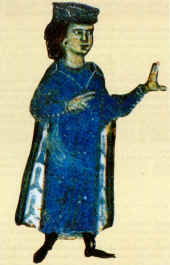
William IX, called the Troubadour, was the Duke of Aquitaine and Gascony and Count of Poitou between 1086 and his death. He was also one of the leaders of the Crusade of 1101. Though his political and military achievements have a certain historical importance, he is best known as the earliest troubadour—a vernacular lyric poet in the Occitan language—whose work survives.

Raymond VII was Count of Toulouse, Duke of Narbonne and Marquis of Provence from 1222 until his death.
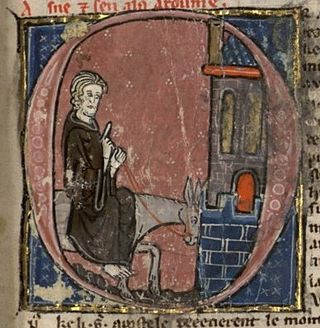
The Chanson d'Antioche is a chanson de geste in 9000 lines of Alexandrin in stanzas called laisses, now known in a version composed about 1180 for a courtly French audience and embedded in a quasi-historical cycle of epic poems inspired by the events of 1097–99, the climax of the First Crusade: the conquest of Antioch and of Jerusalem and the origins of the Crusader states. The Chanson was later reworked and incorporated in an extended Crusade cycle, of the 14th century, which was far more fabulous and embroidered, more distinctly romance than epic.
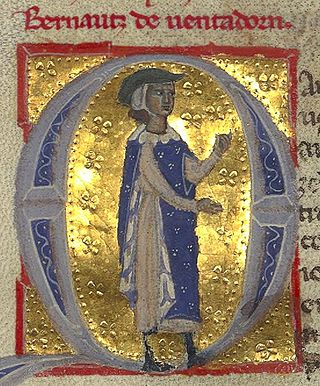
Bernart de Ventadorn was a French poet-composer troubadour of the classical age of troubadour poetry. Generally regarded as the most important troubadour in both poetry and music, his 18 extant melodies of 45 known poems in total is the most to survive from any 12th-century troubadour. He is remembered for his mastery as well as popularization of the trobar leu style, and for his prolific cançons, which helped define the genre and establish the "classical" form of courtly love poetry, to be imitated and reproduced throughout the remaining century and a half of troubadour activity.
Charles the Child was the King of Aquitaine from October 855 until his death in 866.

The Song of the Albigensian Crusade is an Old Occitan epic poem narrating events of the Albigensian Crusade from March 1208 to June 1219. Modelled on the Old French chanson de geste, it was composed in two distinct parts: William of Tudela wrote the first towards 1213, and an anonymous continuator finished the account. However, recent studies have proposed the troubadour Gui de Cavalhon as the author of the second part. It is one of three major contemporary narratives of the Albigensian Crusade, the Historia Albigensis of Pierre des Vaux-de-Cernay and the Chronica of William of Puylaurens being the others.

The Occitan cross is a heraldic cross, today chiefly used as a symbol of Occitania.
Roger I Trencavel,, was the eldest son of Bernard Ato IV, Viscount of Albi, Agde, Béziers, Carcassonne, Nîmes, and Razès. On his father's death in 1130 he inherited Albi, Carcassonne, and Razès, while his younger brother Raymond inherited Agde and Béziers and his youngest brother Bernard Ato V inherited Nîmes.
Marcoat was a minor Gascon troubadour and joglar who flourished in the mid twelfth century. He is often cited in connexion with Eleanor of Aquitaine and is placed in a hypothetical "school" of poetry which includes Bernart de Ventadorn, Marcabru, Cercamon, Jaufre Rudel, Peire Rogier, and Peire de Valeria among others. Of all his works, only two sirventes survive: Mentre m'obri eis huisel and Una re.us dirai, en Serra.

Peirol or Peiròl was an Auvergnat troubadour who wrote mostly cansos of courtly love in the late twelfth and early thirteenth centuries. Thirty-four surviving poems written in Occitan have been attributed to him; of these, seventeen have surviving melodies. He is sometimes called Peirol d'Auvergne or Peiròl d'Auvèrnha, and erroneously Pierol.

Jordan Bonel, sometimes also de Confolens, was a troubadour from western Aquitaine about whom very little is definitively known except that he was associated with the court of Alfonso II of Aragon. His vida states that he was from Saintonge and he appears to have been contemporary with Bertran de Born. His surviving corpus probably consists of three cansos, wherein only one is attributed to him, though its melody survives:
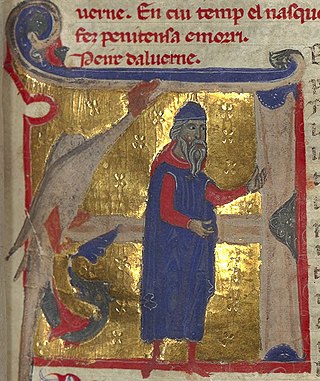
Peire d'Alvernhe or d'Alvernha was an Auvergnat troubadour with twenty-one or twenty-four surviving works. He composed in an "esoteric" and "formally complex" style known as the trobar clus. He stands out as the earliest troubadour mentioned by name in Dante's Divine Comedy.
Jordan Fantosme was an Anglo-Norman historian and poet. He was a cleric and probably the spiritual chancellor of the Diocese of Winchester. His major work is an Anglo-Norman verse chronicle of the war between Henry II of England and his son Henry the Young King and William I of Scotland in 1173–1174. As literature, it stands, according to its latest editor, "absolutely first class".
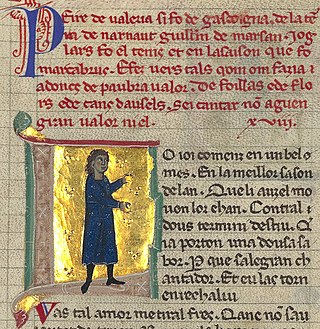
Peire de Valeira, Valeria, or Valera was a Gascon troubadour. Since troubadour poetry probably originated in northwest Aquitaine and first spread—within a generation—south into Gascony, Peire was one of the earliest troubadours. Only two of his poems survive, one canso and one cobla.

Uc, Uco, or Ugo de Pena or Penna was a troubadour of the late 12th and early 13th centuries. He left behind three cansos and no music.
A Crusade song is any vernacular lyric poem about the Crusades. Crusade songs were popular in the High Middle Ages: 106 survive in Occitan, forty in Old French, thirty in Middle High German, two in Italian, and one in Old Castilian. The study of the Crusade song, which may be considered a genre of its own, was pioneered by Kurt Lewent. He provided a classification of Crusade songs and distinguished between songs which merely mentioned, in some form, a Crusade from songs which were "Crusade songs". Since Lewent, scholars have added several classifications and definitions of Crusade songs. Scholars have argued for three different classifications of Crusade songs which include songs of exhortation, love songs, and songs which criticize the Crusading movement.
Gouffier of Lastours was a knight from Lastours in the Limousin in France, who participated in the First Crusade. He was lord of the Château de Lastours, near Nexon, Haute-Vienne.
Eustorge de Scorailles was the bishop of Limoges from 1106 until his death in 1137. He belonged to the local nobility, and was chosen by the cathedral chapter in an election free of outside interference.
Aigar e Maurin is an anonymous Old Occitan epic poem of the twelfth century. The whole work does not survive, but 1,437 lines are known from two damaged fragments. The lines are decasyllabic and divided into 44 rhyming laisses. The fragments—two single folios—were bound in a legal manuscript of the sixteenth century.












